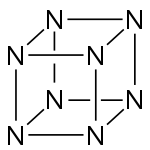Octaazacubane
 | |
 | |
| Names | |
|---|---|
| Other names
Octaazapentacyclo[4.2.0.02,5.03,8.04,7]octane; Cubaazane; Nitrogen octaatomic molecule | |
| Identifiers | |
3D model (JSmol) |
|
| |
| Properties | |
| N8 | |
| Molar mass | 112.06 g·mol−1 |
| Density | 2.69 g/cm3 (predicted)[1] |
Except where otherwise noted, data are given for materials in their standard state (at 25 °C [77 °F], 100 kPa). | |
| Infobox references | |
Octaazacubane is a hypothetical explosive allotrope of nitrogen with formula N8, whose molecules have eight atoms arranged into a cube. (By comparison, nitrogen usually occurs as the diatomic molecule N2.) It can be regarded as a cubane-type cluster, where all eight corners are nitrogen atoms bonded along the edges.[2] It is predicted to be a metastable molecule, in which despite the thermodynamic instability caused by bond strain, and the high energy of the N–N single bonds, the molecule remains kinetically stable for reasons of orbital symmetry.[3]
Explosive and fuel
Octaazacubane is predicted to have an energy density (assuming decomposition into N2) of 22.9 MJ/kg,[4] which is over 5 times the standard value of TNT. It has therefore been proposed (along with other exotic nitrogen allotropes) as an explosive, and as a component of high performance rocket fuel.[5] Its velocity of detonation is predicted to be 15,000 m/s, much (48.5%) more than octanitrocubane, the fastest known nonnuclear explosive.[1]
Cubic gauche nitrogen has an energy density of 33 MJ/kg exceeding octaazacubane by 50%.[6]
See also
- Tetranitrogen (Nitrogen allotrope with formula N4)
- Hexazine (Nitrogen allotrope with formula N6)
- Azidopentazole (Nitrogen allotrope with formula N8)
- Bispentazole (Nitrogen allotrope with formula N10)[7]
- Bis(pentazolyl)diazene (Nitrogen allotrope with formula N12)
- Eicosaazadodecahedrane (Nitrogen allotrope with formula N20)[8]
- Hexacontaazabuckminsterfullerene (Nitrogen allotrope with formula N60)[9][10]
- Pentazole
- 1,1′-Azobis-1,2,3-triazole
References
- 1 2 Agrawal, Jai Prakash (2010). High Energy Materials: Propellants, Explosives and Pyrotechnics. Wiley-VCH. p. 498. ISBN 978-3-527-62880-3.
- ↑ B. Muir. "Cubane"(See under "further topics" section.)
- ↑ Patil, Ujwala N.; Dhumal, Nilesh R.; Gejji, Shridhar P. "Theoretical studies on the molecular electron densities and electrostatic potentials in azacubanes". Theoretical Chemistry Accounts: Theory, Computation, and Modeling (Theoretica Chimica Acta). 112. p. 27–32. doi:10.1007/s00214-004-0551-2.
- ↑ Glukhovtsev, Mikhail N.; Jiao, Haijun; Schleyer, Paul von Ragué. "Besides N2, What Is the Most Stable Molecule Composed Only of Nitrogen Atoms?". Inorganic Chemistry. 35. p. 7124–7133. doi:10.1021/ic9606237.
- ↑ "Exploding the mysteries of nitrogen". Chemistry and Industry.
- ↑ Yoo, Choong-Shik (February 2003). "Novel Functional Extended Solids at Extreme Conditions". DTIC. p. 11. Retrieved 5 October 2015.
- ↑ Manaa, M. R. (2000). "Toward new energy-rich molecular systems: From N10 to N60". Chemical Physics Letters. 331 (2–4): 262–268. doi:10.1016/S0009-2614(00)01164-7.
- ↑ Charkin, O. P. (2013). "Theoretical study of N20, C20, and B20 clusters "squeezed" inside icosahedral C80 and He80 cages". Russian Journal of Inorganic Chemistry. 58: 46–55. doi:10.1134/S0036023613010038.
- ↑ Wang, L. J.; Zgierski, M. Z. (2003). "Super-high energy-rich nitrogen cluster N60". Chemical Physics Letters. 376 (5–6): 698. doi:10.1016/S0009-2614(03)01058-3.
- ↑ https://www.llnl.gov/str/June01/Manaa.html